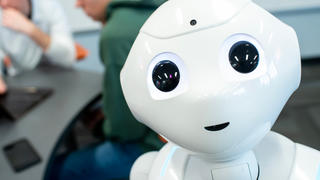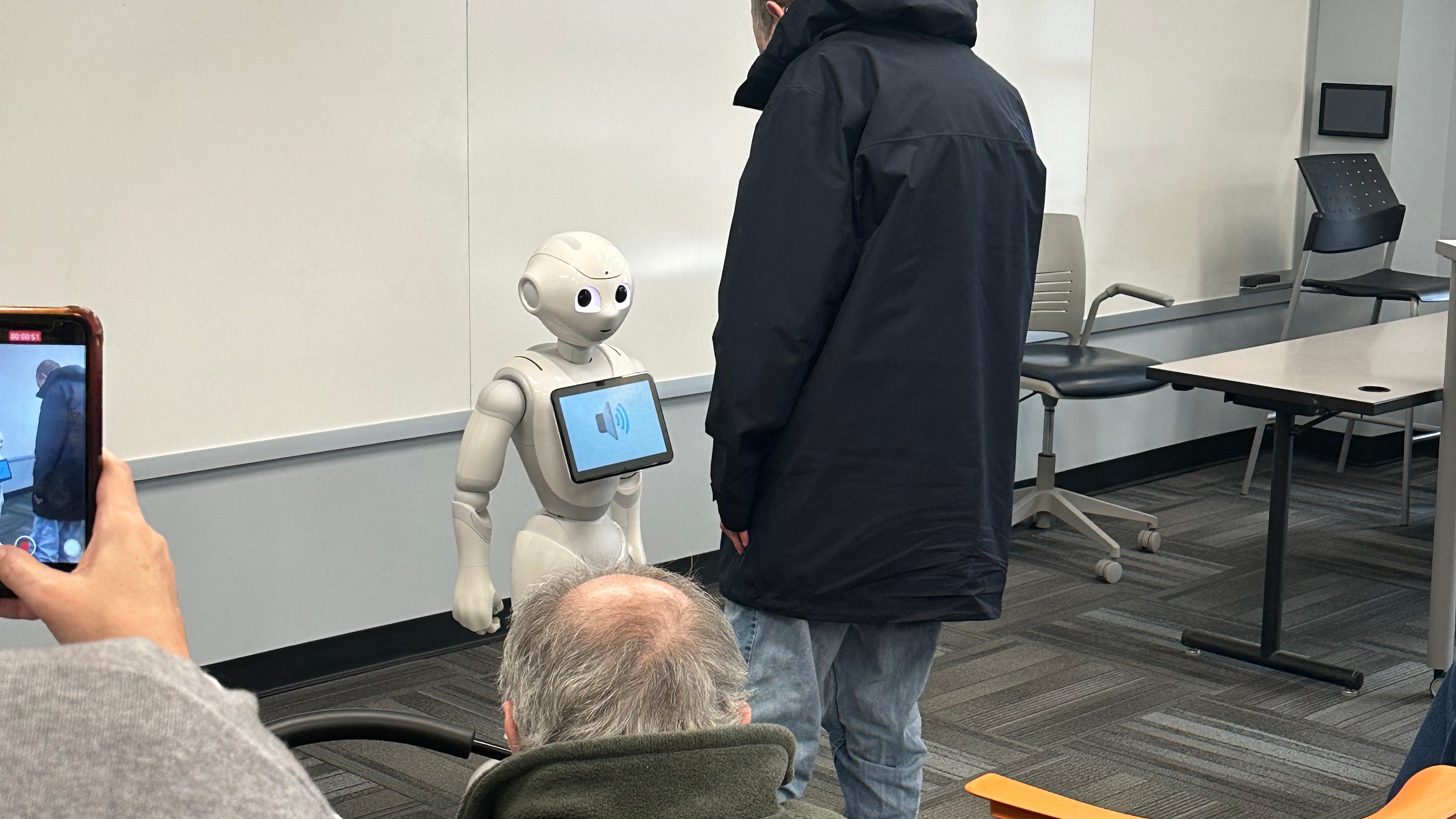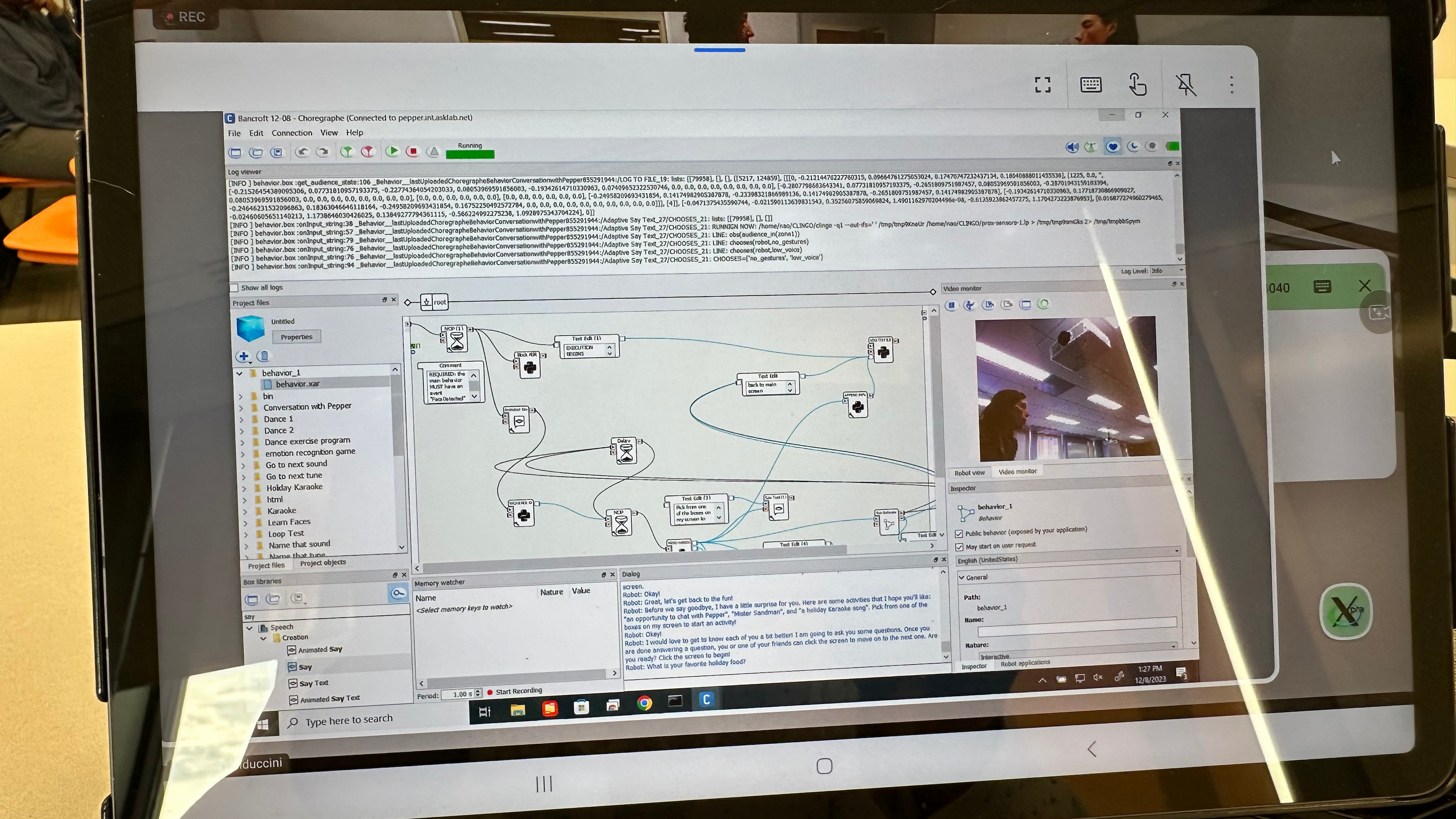Using Robots and Artificial Intelligence to Help Adults with Disabilities
Through the use of artificial intelligence, Saint Joseph’s and Bancroft are working together to create robotic aids for people with cognitive and physical disabilities.

Linda Miller stopped by the grand opening of the Frances M. Maguire Art Museum last May when she unexpectedly heard a robotic voice.
"What the heck is that," she recalls wondering. Miller, a therapeutic activities coordinator at Bancroft, specializes in developing human relationships. "I had to see what that was."
Miller walked toward the voice and came face-to-face with Saint Joseph’s humanoid robot, Iggy, and Marcello Balduccini, PhD, associate professor of decision and system sciences and director of the Haub Innovation Center.
“I pressed one of the buttons and listened to the robot explain an exhibit,” says Miller. “I asked Marcello, ‘Have you ever considered using this to help people with intellectual disabilities?’”
With that question, a collaboration began. Now, Saint Joseph’s and Bancroft — a nonprofit provider of programs and services for individuals with autism, intellectual and developmental disabilities and those in need of neurological rehabilitation — are working together on an ongoing partnership aimed at using AI to create robotic aids for people with cognitive and physical disabilities.
This kind of work is nothing new to Saint Joseph’s professors. Since the grand opening of the Frances M. Maguire Art Museum, Sara Girotto, PhD, adjunct professor of psychology, has been using Iggy to enrich visitors’ experiences of public spaces, such as museums, which may be challenging to navigate for some audiences. Iggy can teach others about art history through remote guidance, interaction and engagement, technology integration and more. Now, Girotto is also part of the collaborative effort with Bancroft.
“It is all about innovation and improving people’s lives,” says Girotto. “We are looking at how this technology can help people maintain their physical and cognitive abilities. Furthermore, we are looking at how it could help [Bancroft] staff feel less overwhelmed.”
Karen Lindgren, PhD, chief clinical officer at Bancroft, shares the same sentiment as Girotto.
“Iggy has so many possibilities,” says Lindgren. “I’m amazed by how lifelike it is and its potential to use AI to meet the individual needs of those in our care. I’m truly looking forward to a future partnership with Saint Joseph’s steeped in the endless possibilities of technology to support those with disabilities.”
Not only is this an exciting opportunity for Bancroft and professors, but students too. Jackie Wurman, BS ’24, a neuroscience major and data science and psychology minor, has been involved in this collaboration from the beginning.
“I’m involved in every aspect of the project, from planning to programming to observing,” says Wurman. “These aren’t everyday opportunities, so you have to jump on them. I am grateful I get to apply some of my knowledge from the classroom to a research setting at such an early point in my career. This project has the potential to help so many people.”
So far, Bancroft residents have visited Saint Joseph’s Haub Innovation Center and interacted with Iggy on several occasions. From multiple-choice games to karaoke, the research team is currently monitoring these interactions on an observational level. For example, they collect data on the time it takes for residents to push a button, how often they select a certain activity and who interacts with Iggy the most.
However, in the near future, the research collaborators want to submit a formal request to an Institutional Review Board (IRB) to develop surveys and get the residents’ feedback. IRBs assess the ethics and safety of research studies involving human subjects. So, while the collaboration may be in its infancy, the future is bright.
“There is a lot of turnover in this field,” says Miller. “There are certain things that staff members can do that Iggy will never be able to do. However, Iggy could be a helper. For example, if Iggy could understand what a resident with poor verbal communication is trying to say and interpret it for staff members, that would be huge.”
Balduccini recognizes the technology’s immense potential. His goal is to develop artificial intelligence components that can detect people’s disposition and needs.
“To the best of my knowledge, nobody has attempted to use robots this way. So, to me, it is fascinating. If we can do it, that will be a major milestone.”
Marcello Balduccini, PhD
Associate professor of decision and system sciences and director of the Haub Innovation CenterHelping Bancroft residents is just one part of the equation. Balduccini hopes that artificial intelligence and robotic aids can revolutionize the healthcare industry.
“Iggy could be one appendage in a whole ecosystem that knows everything about patients,” says Balduccini. “Robotic aids could know a patient's preferences, their physical and cognitive capabilities, health history and more. Then, staff and psychologists could interact with this ecosystem like we do now with ChatGPT. They could ask about behavioral changes or issues that may arise. The system could provide staff with evidence, leading to discussions about developing different behavioral programs, for example.”
These developments will take time. For now, Miller, Balduccini, Girotto and Wurman are scheduling when the Bancroft residents can return to the Haub Innovation Center and continue researching these interactions.



